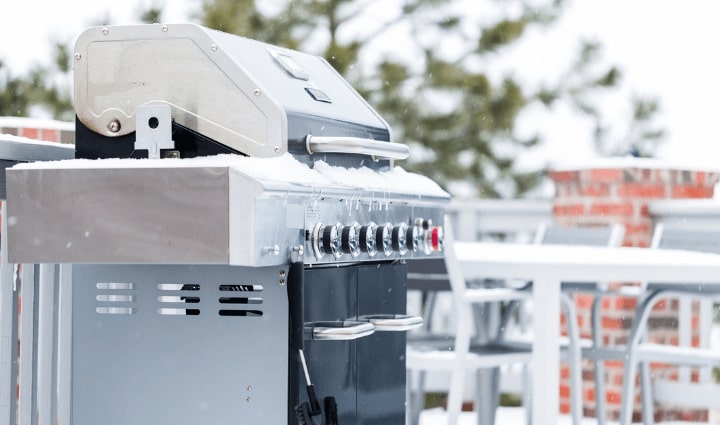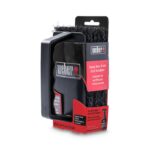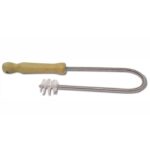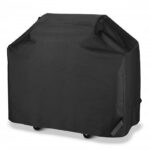It may not feel like it in some parts of the country, but winter is on its way. If you’re enjoying an extended grilling season in your region, take advantage of the warmer temperatures and use the time to get your gas grill ready for winter before the cold weather and snow hit. We all know it’s coming, as hard as it may be to admit.
Preparing your grill for winter storage isn’t as simple as covering it up or stowing it away in a shed. It’s not a ton of work, but if you plan to store your grill for the winter, you should set aside an afternoon before the snow flies to get your grill ready for its long hibernation. Making sure your grill is clean and in good condition before it gets stored ensures that your grill will be ready to fire up with minimal prep when spring arrives. It also gives you an opportunity to identify and fix any issues that may worsen if they go unnoticed for months, such as rust, mold, and other deterioration.
If you don’t plan to store your grill and intend to fire it up even after the snow starts to fly, it’s still a good idea to give your barbecue a deep clean while the weather is good. In addition to keeping your grill functioning at its best through the colder months, a thorough cleaning is also the perfect opportunity to identify problems and replace parts or make any necessary repairs.
Read our guide to winterizing your grill, including how to prepare a gas grill for storage, how to store your propane tank, and how to winterize a charcoal grill.
How to Winterize a Gas Grill
Whether you plan to use your gas grill in winter or store it away till spring, it’s worth taking an afternoon to give it a thorough cleaning and properly prepare it for the coming winter.
Follow these steps to winterize your grill and make sure your BBQ is in tip-top shape:
1. Disconnect your propane tank or natural gas line
Always disconnect the gas line before you start disassembling and cleaning your grill.
If you’re storing a propane grill indoors, leave the propane tank disconnected and follow our directions for storing a propane tank.
If you’re storing your propane grill outdoors for the winter or plan to grill year-round, you can reconnect the gas line once you’ve finished cleaning and inspecting your grill and store your grill and propane tank together.
2. Clean your grill
Thoroughly clean your grill from top to bottom, including the cooking grates, heat plates, burners, drip tray, and the grill exterior.
Start by heating the grill for 15 minutes to burn off any leftover grease and food residue, then scrub the grates with a bristle brush and scrape away any stubborn bits with a putty knife. Pay attention to the inside of the grill cabinet, as well as any drawers or compartments, and wipe away any food debris that may have collected.
Cleaning your grill before you store it will save you a lot of work when the snow thaws and it’s time to pull your gas grill back out in the spring. Removing food debris before you store your grill will also help prevent corrosion, and will make your grill a less tempting target for pests like mice or insects while it hibernates through the long winter.
Read our guide for step-by-step instructions for cleaning your gas grill.
3. Inspect your grill for damage
While you clean, take the time to inspect your grill for damage. Look closely at the cooking grates, gas line, and control knobs for any broken parts or signs of deterioration, and check the grill’s exterior for cracks and dents. If you notice any significant deterioration, it may be time to replace these parts.
Don’t forget to inspect the grill’s interior components as well, including the burners and heat plates. If your burners or heat plates are rusting or flaking or you’re noticing inconsistent heat, uneven flames, or more flare ups, it may be time to replace the burner or heat plates.
4. Prepare your grill for storage
If you plan to store your grill, there are a number of things you can do to prepare it for winter storage once it’s been cleaned:
- Coat the grill grates with a light layer of cooking oil to block moisture and prevent rust, then heat the grill to vaporize excess oil and season the grates.
- Clean and polish your grill’s exterior for extra protection.
- Remove the burners and wrap them in plastic to keep spiders and insects from nesting in the gas tubes over the winter.
- If your grill has an electric ignition system, remove the battery so the battery doesn’t drain and the contacts don’t erode.
- For outdoor storage, reconnect your propane tank and ensure the valve is in the off position. For indoor storage, leave your propane tank disconnected and store it outdoors. Do not store your propane tank in your house, garage, or shed.
5. Cover your grill
If you’re storing your grill outdoors or will be grilling through the winter, look for a heavy-duty grill cover made using weather-resistant materials. For indoor storage, you can use your standard summer grill cover.
Is It Okay To Leave A Gas Grill Outside in Winter?
Yes, it’s okay to leave a gas grill outside in winter! Especially if you plan to grill year-round.
Not everyone has room in their shed or garage to store their gas grill in the winter. If you don’t have space indoors to store your grill, it’s totally okay to store it outdoors.
If you’re storing your grill outdoors, be sure to invest in a heavy-duty, weather-resistant cover. You can also leave the propane tank attached, especially if you plan to grill throughout the winter months.
How to Store a Propane Tank in Winter
Never store a propane tank indoors—including in your shed or garage.
The only place to safely store a propane tank is outdoors. Don’t worry—your propane tank will weather the cold winter just fine. Winter temperatures don’t pose a threat to your propane tank.
If you’re storing your entire grill outdoors or plan to grill year-round, keep the propane tank connected (but shut off) and cover the grill. If you’re storing your grill indoors, remove the tank and store it in a dry, open, well-ventilated outdoor area. The best place to store your propane tank is on a flat surface at least 10 feet away from other propane and grilling accessories or anything else that’s flammable.
Cover the tank in a plastic tarp to keep water and ice from building up on the tank. This will help prevent rusting and help extend the life of the tank. Always store the rank in a secure, upright position.
How to Winterize a Charcoal Grill
Winterizing a charcoal grill is similar to preparing a gas grill for the colder months. Follow these steps:
- Light up the grill one last time. Let it burn at at least 500 degrees for a few hours to cook off any heavy grease.
- Clean the grill. Remove any food scraps and wash away residue, then scrape the grates with a bristle brush and sweep out any ashes from the bottom of the cooker.
- Season the cooking grates with cooking oil, or store them in plastic bags to keep pests away.
Is Your Grill Ready for Winter?
Taking the time to clean and prepare your grill for storage over the winter months can save you a lot of trouble when spring arrives. Properly winterizing your grill helps prevent corrosion, oxidization, and other deterioration, and makes your grill a less tempting target for insects and other pests that may find it an appealing place to call home over the winter.
If you plan to use your grill this winter, giving it a thorough cleaning and an inspection before the snow flies ensures that it’ll be in top condition all year round.





